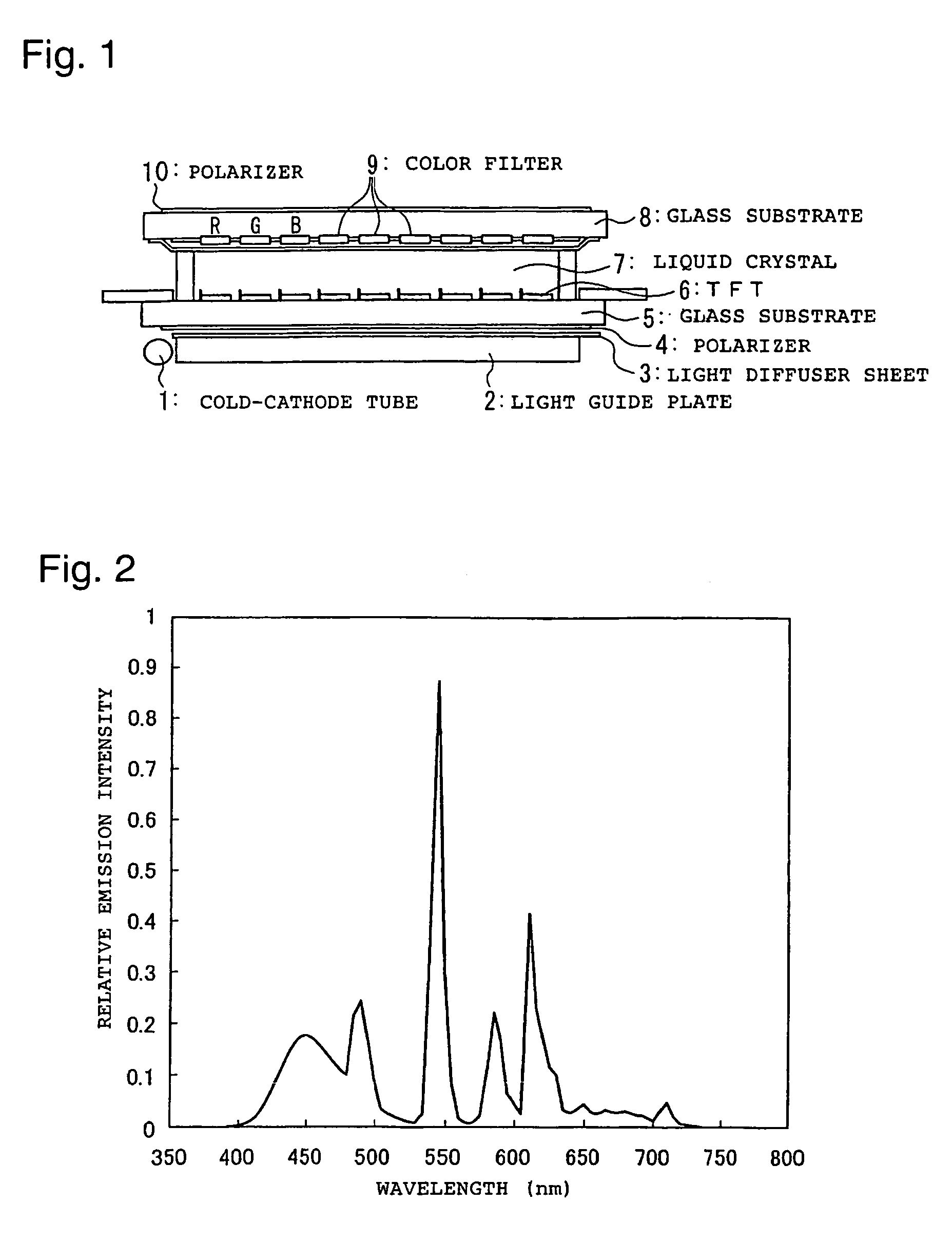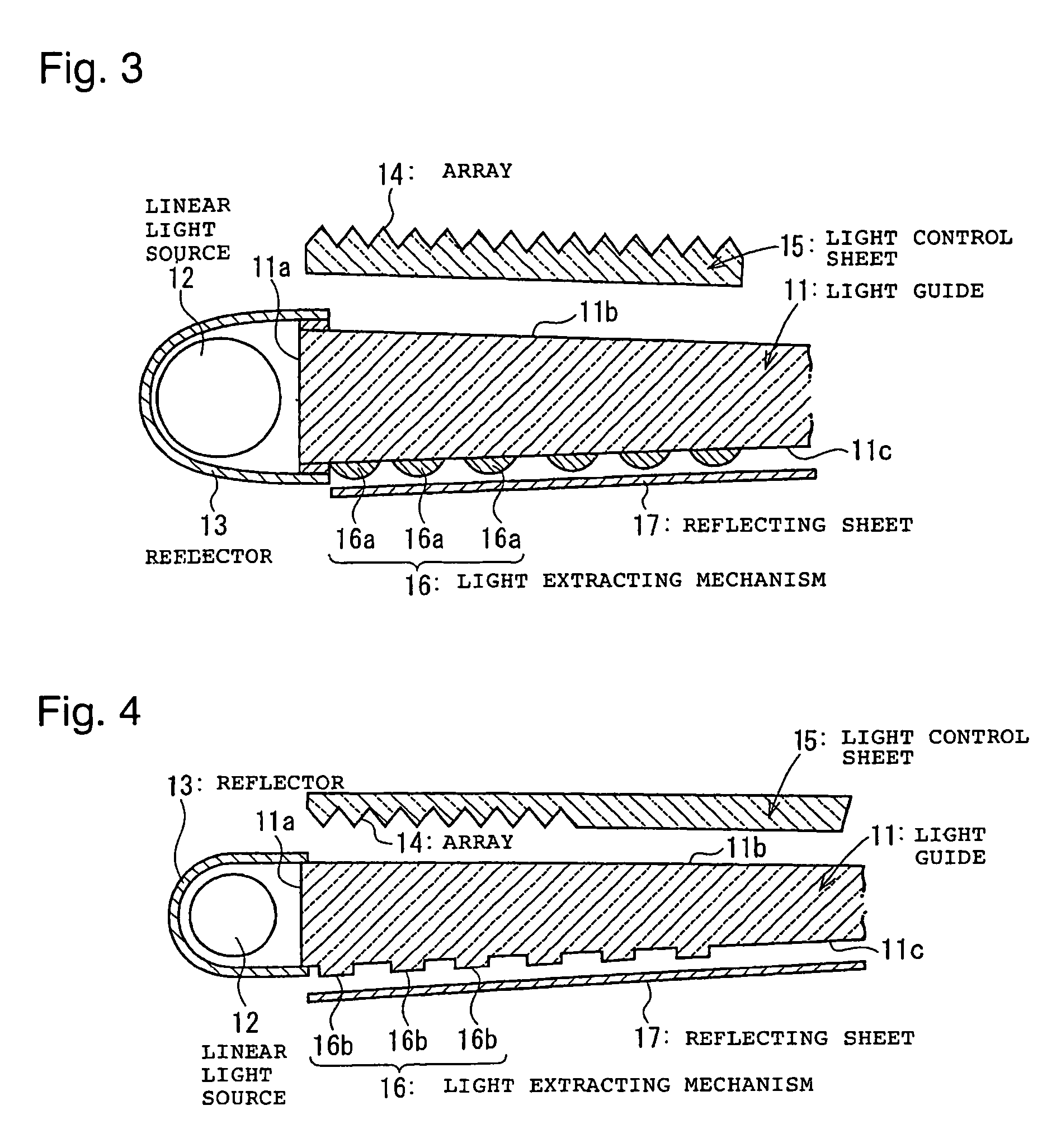Color liquid crystal display devices
a liquid crystal display and liquid crystal technology, applied in the field of color liquid crystal display devices, can solve the problems of affecting the expansion of affecting the color reproduction range of liquid crystal display elements, and increasing the absorption in the principal emission regions, so as to improve the chromatic purities of both green and red
- Summary
- Abstract
- Description
- Claims
- Application Information
AI Technical Summary
Benefits of technology
Problems solved by technology
Method used
Image
Examples
preparation example 1
Preparation of Backlight ①
[0213]A phosphor slurry was prepared by thoroughly mixing 52 parts of Y2O3:Eu (trade name “LP-RE1” manufactured by KASEI OPTONIX, LTD.) as a red phosphor, 18 parts of BaMgAl10O17:Eu,Mn (trade name “LP-G3” manufactured by KASEI OPTONIX, LTD.) in the composition of Ba09Eu0.1O(Mg0.79Mn0.21)O.5Al2O3 as a green phosphor, and 30 parts of BaMgAl10O17:Eu (trade name “LP-B4” manufactured by KASEI OPTONIX, LTD.) as a blue phosphor with butyl acetate and nitrocellulose lacquer, applied and dried on an internal surface of a glass tube with a tube diameter of 2.3 mm, and then baked at 620° C. for five minutes. Thereafter, a cold-cathode tube for a backlight was fabricated by the ordinary procedure of attachment of electrodes, evacuation, Hg and gas introduction, sealing, and so on.
[0214]Then a cyclic polyolefin type resin sheet (trade name “ZEONOR” manufactured by ZEON CORPORATION) of wedge shape, which had the size of 289.6×216.8 mm and thicknesses varying along the di...
preparation example 2
Preparation of Backlight ②
[0219]A cold-cathode tube for a backlight was fabricated in the same manner as in Preparation Example 1 except for use of 40 parts by weight of a YVO4:Eu3+ type phosphor (trade name “MGV-620” manufactured by KASEI OPTONIX, LTD.) as a red phosphor, 22 parts by weight of a LaPO4:Ce,Tb phosphor (trade name “LP-G2” manufactured by KASEI OPTONIX, LTD.) as a green phosphor, and 38 parts by weight of BaMgAl10O17:Eu (trade name “LP-B4” manufactured by KASEI OPTONIX, LTD.) as a blue phosphor, and a. backlight ② was prepared therefrom in the same manner as in Preparation Example 1. A relative emission spectrum of the backlight thus obtained is presented in FIG. 6.
[0220]This backlight ② had the principal emission wavelengths of red: about 620 nm, blue: about 450 nm and green: about 545 nm.
preparation example 3
Preparation of Backlight ③
[0221]A cold-cathode tube for a backlight was fabricated in the same manner as in Preparation Example 1 except for use of 40 parts by weight of a YVO4:Eu3+ type phosphor (trade name “MGV-620” manufactured by KASEI OPTONIX, LTD.) as a red phosphor, 22 parts by weight of BaMgAl10O17:Eu,Mn (trade name “LP-G3” manufactured by KASEI OPTONIX, LTD.) in the composition of Ba0.9Eu0.1O.(Mg0.79Mn0.21)O.5Al2O3 as a green phosphor, and 38 parts by weight of BaMgAl10O17:Eu (trade name “LP-B4” manufactured by KASEI OPTONIX, LTD.) as a blue phosphor, and a backlight ③ was prepared therefrom in the same manner as in Preparation Example 1. A relative emission spectrum of the backlight thus obtained is presented in FIG. 7.
[0222]This backlight ③ had the principal emission wavelengths of red: about 620 nm, blue: about 450 nm and green: about 515 nm.
PUM
| Property | Measurement | Unit |
|---|---|---|
| wavelength | aaaaa | aaaaa |
| wavelength | aaaaa | aaaaa |
| wavelength region | aaaaa | aaaaa |
Abstract
Description
Claims
Application Information
 Login to View More
Login to View More - R&D
- Intellectual Property
- Life Sciences
- Materials
- Tech Scout
- Unparalleled Data Quality
- Higher Quality Content
- 60% Fewer Hallucinations
Browse by: Latest US Patents, China's latest patents, Technical Efficacy Thesaurus, Application Domain, Technology Topic, Popular Technical Reports.
© 2025 PatSnap. All rights reserved.Legal|Privacy policy|Modern Slavery Act Transparency Statement|Sitemap|About US| Contact US: help@patsnap.com



